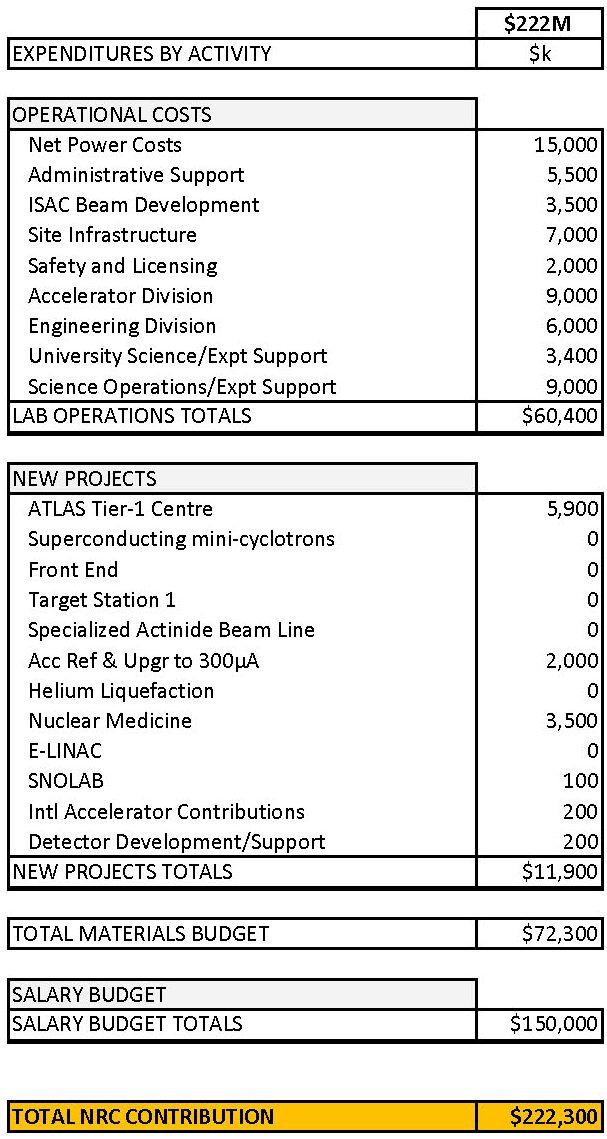MEMORANDUM
Date: Friday, March 5, 2010
To: TRIUMF Community, Stakeholders, and Patrons
From: Nigel S. Lockyer, Director
RE: Proposed Implementation for Five-Year Plan 2010-2015
The Government of Canada has announced its support for TRIUMF in Budget 2010. In terms of investment via the NRC Contribution Agreement, the total is $222 million over five years. This funding level is identical to what was provided five years ago for the 2005-2010 funding period. Given the challenges of the current fiscal climate, I welcome this news as it indicates confidence in TRIUMF, our plan, and what we promise to do for Canada's future. Our base operating funds are secure. Compared to other national initiatives or to programs in other countries during this recession/recovery period, we have much to work with.
This funding will not support all of our aspirations, but it will allow us to focus on our strengths and move some key initiatives forward. There is an increasing expectation that the Five-Year Plan should primarily support basic laboratory operations while large, new initiatives should seek external funding sources.
Changes to the Scenarios
In summer 2008, the 2010-2015 Five-Year Plan was crafted with multiple scenarios to accommodate different levels of federal investment. These scenarios evaluated explicit tradeoffs and proposed an optimized portfolio of activities for each budget level. In the intervening two years, those basic scenarios have been updated by two principal developments.
- The University of Victoria was successful in leading a national proposal to the Canada Foundation for Innovation (CFI) for support of a superconducting electron linear accelerator at TRIUMF (the e-linac).
- Because of the delayed startup of the Large Hadron Collider at CERN, the schedule of the capital needs for the ATLAS Tier-1 Data Centre has been adjusted. This change reduces the level of funding required from the Five-Year Plan to operate the Data Centre.
Proposed $222M Program for 2010-2015
Scenario D of the Five-Year Plan maps onto our $222M funding level. It has been modified by reinvesting the "savings" from the ATLAS Tier-1 Data Centre into laboratory operations and support for university science. Thus, the TRIUMF program supported by the NRC Contribution Agreement would consist of (see Table 1 below for the full listing):
- Exploitation of the existing ISAC and cyclotron-based science programs;
- Targeted cyclotron refurbishment;
- Limited support for university-led CFI and other projects;
- Expansion of the nuclear-medicine program; and
- Full support for the ATLAS Tier-1 Data Centre.
The scope of TRIUMF's work naturally dictates the level and skills mix of the required staffing. The proposed program of work will require some reduction in personnel. These changes will mostly come from retirements and attrition, reassignment of personnel, and carefully aligning new hires with overall laboratory priorities. We are working hard to develop a realistic plan for managing staffing that will be ready by April 1. I am committed to a calm, open, and honest approach to these issues.
Our present understanding is that the $3.4M budget for university support and experiments will provide the TRIUMF share of the funds needed to complete IRIS, GRIFFIN, and EMMA.
ARIEL and the E-linac
The flagship initiative in this Five-Year Plan is the Advanced Rare-IsotopE Laboratory (ARIEL) program. ARIEL includes the e-linac, the specialized actinide beam line (aka proton beam line), high-power target stations, a mass separator and front-end that connects with ISAC, and the associated conventional facilities and infrastructure. The $222M budget is not compatible with a full ARIEL program by 2015.
However, funding for the e-linac and the supporting civil construction is within reach. Through the University of Victoria and its partners, funding for the e-linac has been awarded by CFI. The Province of British Columbia has been extremely supportive of TRIUMF and I am waiting for confirmation of provincial matching funds to the CFI award. In order to release the combination of CFI and provincial funding, TRIUMF will need to commit the required personnel to design, construct, and commission the e-linac. The CFI award includes a contribution for operations. We estimate the e-linac effort to require about 110 FTE-years over the next 5 years. Identifying this manpower from within the TRIUMF staff will require setting priorities among all our commitments. We would seek external funding sources (such as the new $35M Medical Isotopes program announced for Natural Resources Canada) to support the capital and personnel required for the target station and front end.
I believe we should seize this opportunity, although it will take something extra from all of us.
Conclusion
The federal budget will not be final until it is passed by the House. My request to the broader community is to review this proposal and reflect on its overall consistency with the spirit of the Five-Year Plan as presented in August 2008. I have asked a number of specific stakeholder groups to submit written commentary on this point.
Thank you for your participation in, contribution to, and patience with the TRIUMF Five-Year Plan process. This plan, this laboratory, and all of Canada, is better because of your efforts.
I look forward to fulfilling the vision of this Five-Year Plan and to delivering a "gold medal" for Canada in the next five years.

